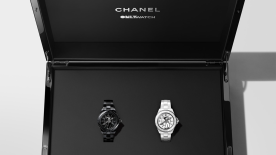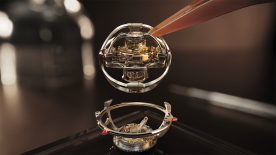What is Hermès time? It’s an evolving, ephemeral concept. It’s playful and unique; it combines a mischievous and irreverent side with a spirit of innovation.
How would you go about defining it? We prefer simple answers, so, why not just go and look at a Hermès watch? Unfortunately, it’s not as easy as that. The brand has made no secret of its wish to create a sense of time that is fluid and personal, that defies measurement, in fact. And that makes it all the more surprising to learn that the newest iteration of Hermès’ latest collection, the H08, is a chronograph – the epitome of watchmaking precision.
Heir apparent
The new chronograph is presented in the stunning H08 case which refuses to decide whether it’s round, square or cushion-shaped. Its lines are both hard and soft, highly-strung and chilled-out. The gaze relaxes into the perfectly circular dial, while the case offers far more complex shapes and surfaces.
This new chronograph also features an interplay of materials and finishes. The case is made not of metal but a composite material. Carbon fibres are combined with a resin and graphene powder to create a final colour somewhere between black and charcoal. And, although the surface is perfectly smooth to the touch, the composite layers are clearly visible.

A highly textured dial
The most surprising element is probably the dial. Unlike previous versions, this chronograph model features two subdials with a particularly pronounced grain. The material feels alive, with a definite texture and a mineral-like composition. The grained finish can also be found on the inner flange where the hours are marked off with slender orange markers. Orange accents are also visible on three hands out of the five, and on the crown.
Bespoke typeface
These textures aside, the overall personality of the dial is dictated by the model’s custom typeface. This feature deserves particular attention, because there are very few brands today that take the trouble to create a new font specifically for a watch collection. Often, Arabic or Roman numerals conform to the conventional choices offered by the majority of subcontractors.
But Hermès has taken a different path, designing 12 indexes in a typeface created specially for the H08. The shapes are directly inspired by the geometry of the case, and the family resemblance is particularly visible on figures 6, 8 and 0. The minutes counter (left) and seconds counter (right) also mirror the case shape, contributing to the impression that this is a coherent, convincing and unconventional timepiece.

A discreet pushpiece
In the interests of ensuring that the chronograph was as visually similar as possible to a traditional three-handed model, the crown was designed to be particularly discreet. The result speaks for itself. At first glance, and at first touch, the two cases are extremely similar. Hermès has succeeded in hiding the monopusher inside the crown of the H08, thus preserving the visual identity of the collection.
Urban and sporty
Technically speaking, a cushion-shaped watch cannot have a ‘diameter’. In fact, the case measures 41.2 mm by 40.7 mm, which is almost a square, but not quite. Here, too, we can appreciate the refinement and subtlety of Hermès’ design, which resists being pigeonholed or trapped inside pre-established conventions.
The movement is Hermès’ base calibre, the H1837, with an additional chronograph module. The movement as a whole comprises almost 400 components (393 to be precise), and runs at a rate of 4 Hz (28,800 vph). The case is water-resistant to 100 metres, which makes it suitable for everyday wear but not for sustained use around water. The crystal and case back are made of sapphire, and the watch comes on an orange rubber strap with Hermès’ signature woven motif.





